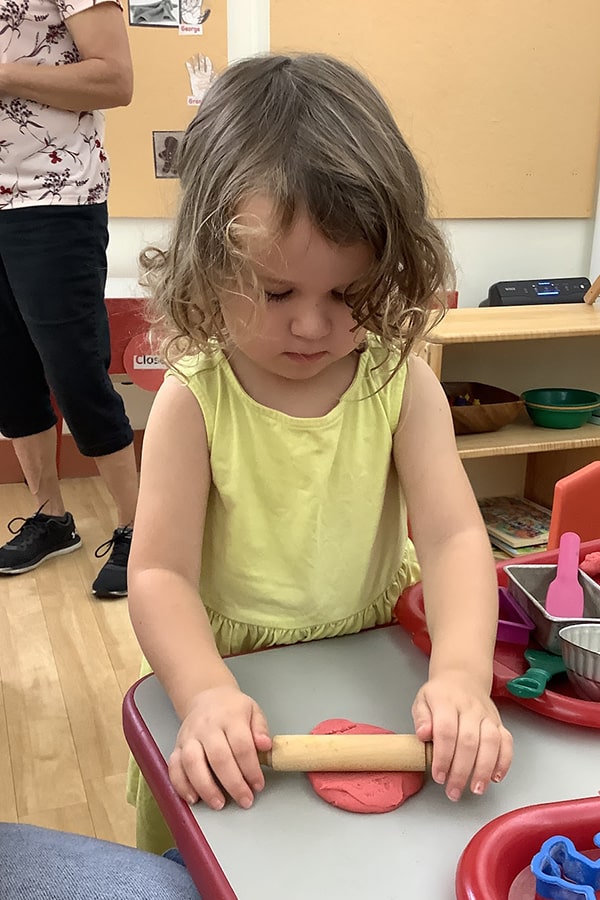May 2025: Exploring Science
To say “exploring science” is almost redundant in that science essentially IS exploration. According to Understanding Science 101, “the way individual humans learn (especially as children) bears a lot of similarity to the progress of science: both children and scientists make observations, consider evidence, test ideas, and hold on to the ideas that work.” They also advocate viewing science as a process that is an exciting, useful, and ongoing global human endeavor because what we learn as we explore the amazing world in which we live raises new questions for investigation. For young children, we start with exploring the science of everyday experience, including our own bodies, our food, our clothing, our pets, etc. Remember that we start with “I notice ___, I wonder ___, I think ___, and (after trying something) I learned ___”.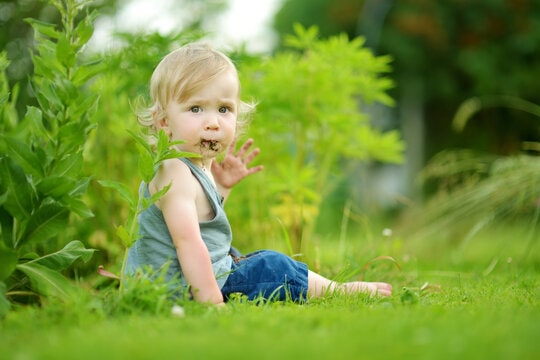 Babies explore everything with their mouths because that’s where they have the strongest sensations and best motor control. So, when we introduce babies to bubbles or paint or chalk, their first exploration strategy is to put each one in their mouth. Similarly, snow, leaves, grass, dirt, and rocks from outdoor explorations go straight to the mouth. Gradually, babies begin to explore other options as we directly tell them that those things are not for eating, model other interesting activities, and allow them to explore, even when it means a lot of mess.
Babies explore everything with their mouths because that’s where they have the strongest sensations and best motor control. So, when we introduce babies to bubbles or paint or chalk, their first exploration strategy is to put each one in their mouth. Similarly, snow, leaves, grass, dirt, and rocks from outdoor explorations go straight to the mouth. Gradually, babies begin to explore other options as we directly tell them that those things are not for eating, model other interesting activities, and allow them to explore, even when it means a lot of mess.
For preschoolers and kindergartners who have developed more self-regulation, better motor skills, and much better receptive and expressive language, we can begin to deepen the explorations with discussions of science concepts and more purposeful experimentation. For example, the kindergartners have been exploring eggs and recently tested whether eggs sink or float. They tested both regular and hard-boiled eggs in fresh versus salt water. Mrs. Sweet invited them to use what they know to make predictions and then hypothesize explanations for the observations. Sometimes, she offered scientific principles, such as that both types of eggs float in salt water but sink in fresh water because the salt molecules add density to the water, which makes it denser than either type of egg. I wonder what happens with sugar water? Or with different types of objects?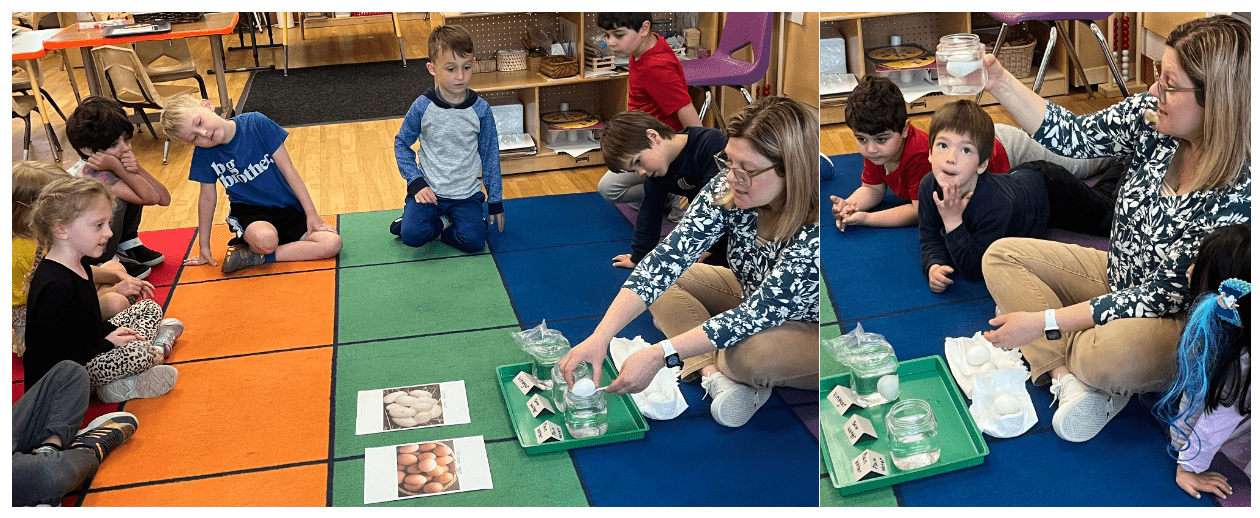
Similarly for the preschoolers, a variety of opportunities for safely exploring their senses this spring have fostered new interests related to their bodies. The educators support this learning in many ways, ranging from simply acknowledging progress, to modeling techniques, to explaining principles. Throughout the process, explorations also strengthen children’s 1) confidence and capability for independent investigation, 2) ability to cooperate and negotiate with peers, 3) effectiveness of communicating their ideas, 4) comfort with multiple attempts and handling challenges, 5) safe self-regulation of motor skills, and 6) creative expressions through art and music.
Through my Director’s Corner series this year, I’ve invited you to consider the question, “Why Explore?” Perhaps I’ve convinced you that there are vast developmental benefits for building important skills in all domains. More than that, explorations foster a positive and proactive approach to learning. Children begin to view themselves as capable and critical thinkers whose discoveries are meaningful to themselves and their communities. Let’s continue partnering to support their growth. Best wishes for broad and deep learning as you encourage exploration adventures with your children this summer!
April 2025: Exploring Building
Have you ever wondered why we offer so many different indoor and outdoor block building opportunities at the Children’s School? Or why we incorporate explorations of building innovations and buildings in our thematic units, like the PreK / Kindergarten’s current study of Ancient Greece?
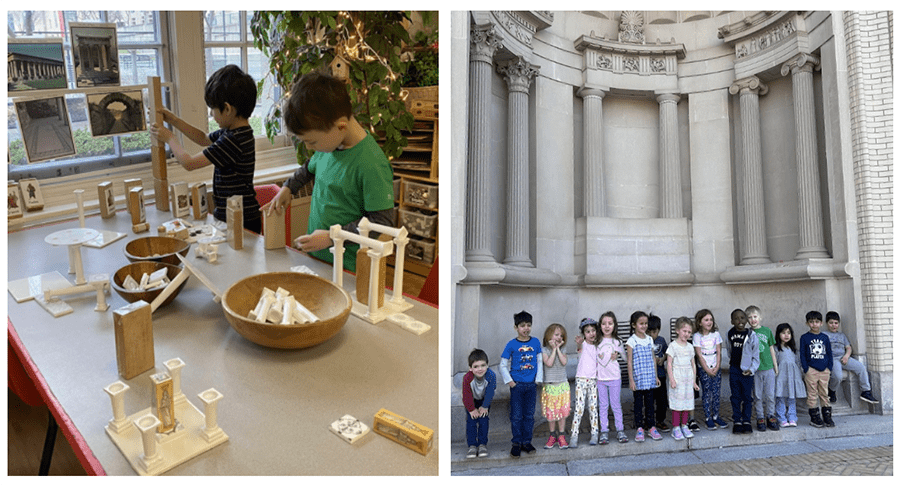
A 2001 study by Wolfgang, Stannard, and Jones found that “block-play performance in preschool is a predictor of mathematics achievement in middle school and high school.” Children typically progress during the early childhood years from carrying and otherwise exploring blocks, to building mostly in rows (either horizontal or vertical), to bridging spaces, to enclosing spaces, to making decorative patterns, to naming structures that they build intentionally (e.g., saying they’re making a zoo), to symbolizing known buildings with blocks. In the process, they explore concepts of gravity as they relate to balance and stability, count and measure building features, strengthen geometric concepts and spatial skills, and discover multiple solutions to building problems (Discovery & Exploration). They strengthen eye-hand coordination, build strength to handle large blocks, manage body movements to avoid bumping structures, follow safety procedures with blocks, etc. (Physical Capabilities / Health & Safety). Given enough time, they can experiment with design, notice varied features of buildings, imagine new constructions, etc. (Artistic Expression & Appreciation). In school, children often work on block building with peers, so they strengthen their skills for sharing materials, coordinating actions, and negotiating cooperative designs (Interaction & Cooperation), as well as practice Communication by discussing plans, writing labels or drawing blueprints, etc. Throughout the exploration, they develop confidence by mastering diverse materials, taking responsibility for cleaning up the space, managing emotions when structures fall, etc. (Self-Esteem & Independence). For another perspective on the value of block play, see this recent article by Todd Erickson, a colleague from Stanford’s Bing Nursery School: Block Building For Overstimulated Children

All of these skills are essential components of the Carnegie Mellon undergraduates’ carnival “build week” experience that was happening right outside our windows as I was writing this article. More sophisticated levels of similar skills are on display every time we have opportunities to watch new campus buildings grow from the basic supports and utility infrastructure to the finished buildings, like the recent Highmark Center across from our main entrance on Margaret Morrison Street. As members of the campus laboratory school community, our children have frequent opportunities to be intrigued and inspired by the adult builders they observe working around them.
Adults can reinforce children’s interests and support their building explorations by:
- Building WITH the children to gently support progress without directing or frustrating them.
- Taking the child’s lead, following the child’s interest, and providing only the support needed.
- Adding people, animals, vehicles, etc. to the selection of blocks to extend the play.
- Allowing children to combine a variety of blocks, as well as diverse recycled materials.
- Allowing children to continue working on a structure for a period of days.
- Encouraging children to dissemble buildings as they assemble them – one block at a time (i.e., rather than knocking or kicking them down).
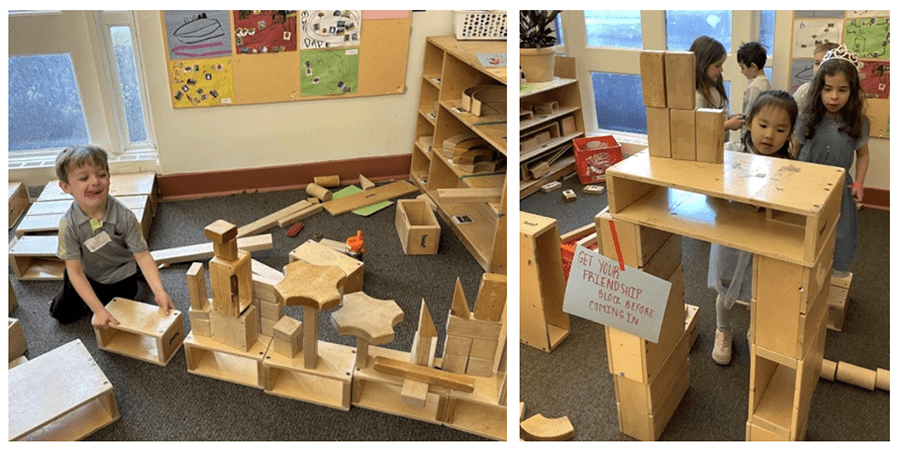
Now that the weather affords more outdoor play, shift the building from blocks to rocks (and other outdoor “loose parts” like sticks, logs, leaves, and moss). Construction with natural materials that have different features challenges the children’s understanding of balance and sense of aesthetics in ways that prompt renewed interest, plus the fresh air and open space have a way of offering inspiration of their own. Be ready with the camera to document the children’s ingenuity!

March 2025: Exploring Cooking
Cooking explorations in early childhood can lay a firm foundation for healthy and more economical food choices throughout life. The first step is involving children in the parts of cooking that fit their motor skills and cognitive abilities. For example, when my granddaughter was 14-months old, I got a text from my daughter saying that her favorite activities were tearing paper and putting things in bowls, so they put her to work making salad. There was an accompanying video clip of Lucia happily shredding a head of lettuce with both hands. Though not all of it went into the bowls, she was clearly thrilled with being actively involved and appreciated. She progressed to chopping carrots with a child-sized chopper at age 2, then using an apple peeler and helping with pie as a preschooler, and now can make an entire pie with a lattice crust on her own.
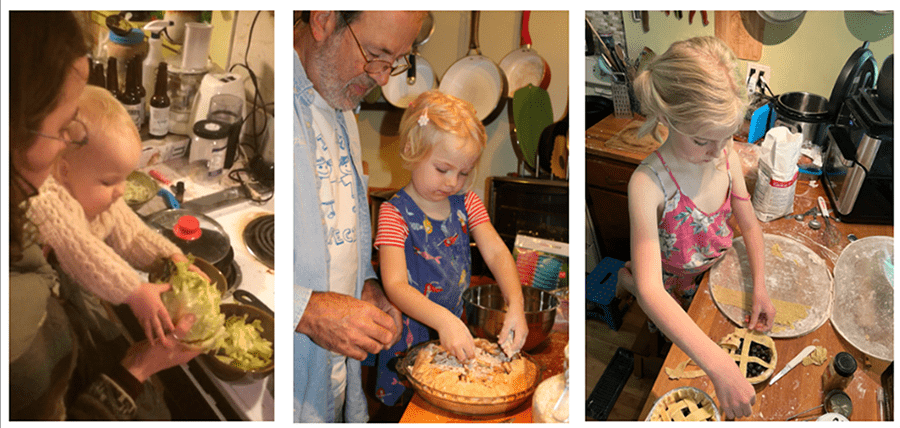
Helping in the kitchen builds valuable Interaction & Cooperation skills for following directions and routines, sharing the work, using polite manners, etc. Cooking experiences are also great opportunities for children to learn new vocabulary for foods, ingredients, utensils, and actions, as well as to begin decoding the print on food packaging and in cookbooks (Communication). Regarding Discovery & Exploration, children get a chance to use all of their senses when cooking, to learn about cause and effect relationships as they explore how utensils and appliances work, to practice diverse ways to measure ingredients and time, and to experience mistakes as part of the learning process. There are many opportunities to build Physical Capabilities while cooking, from movements necessary for slicing, stirring, pouring, etc., as well as those necessary for wiping surfaces and washing dishes. Naturally, there are also Health & Safety lessons to be learned in the kitchen, particularly with respect to sharp or hot surfaces, food storage, nutrition, and allergies. Becoming competent in the kitchen increases children’s Independence, which in turn fosters Self- Esteem, particularly if they are recognized for their contributions and encouraged to learn to make the traditional family meals that become part of special occasions. That’s often where the more Artistic side of cooking can be experienced while helping with food presentation, table-setting, etc.
As with all explorations, adults need to blend a variety of teaching strategies appropriate to the child’s level of skill and the context. Initially, children need direct instruction to learn the basic cooking terms and techniques, particularly for tasks involving safety concerns (e.g., “hands on top when you chop”). With the basics well in hand, they can learn much from observing adult demonstrations, as well as from straightforward hints regarding strategies for handling common challenges. With a solid skill set and appropriate supervision, children can then enjoy the more creative side of cooking by testing novel variations, using typical techniques with atypical ingredients, etc. Our teaching kitchen sets the stage for all the approaches to teaching cooking, such as when our Preschool 3’s recently chopped vegetables to make “Stone Soup”, our Preschool 4’s made oatmeal “Slop” in a crock pot, and our PreK/Kindergartners made pasta from scratch, all dishes related to stories they were reading and retelling.
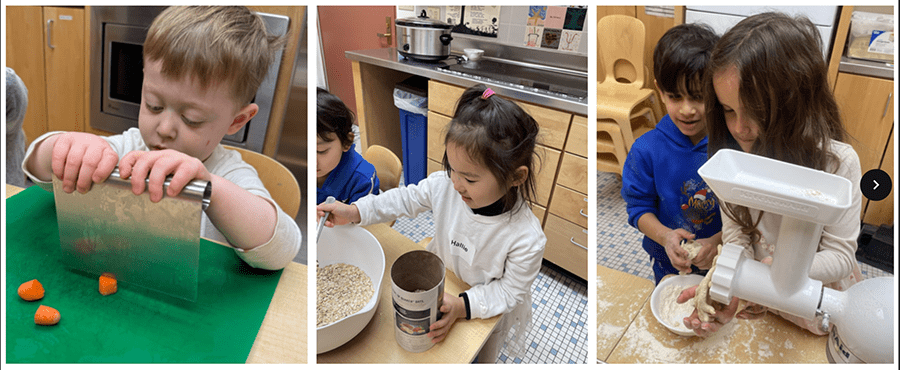
Cooking with adults who model a willingness to try new recipes with novel ingredients also helps children become more adventurous eaters. Be sure you have enough ingredients available to allow children small tastes as you prepare each ingredient, as well as after ingredients are combined. That way, they can discover that the wonderful vanilla flavor in ice cream and other baked items does not taste very good by itself or that many foods can be cooked to taste savory or sweet depending on the spices added. If a food is not initially to a child’s liking, it may take 8-10 tries before a positive response. Be persistent in offering a range of foods, especially at the beginning of meals when the child is most hungry, and be ready to encourage the attempt without forcing. Involving your child in shopping for or even growing foods also encourages tasting. Bon appetit!
February 2025: Exploring Visual Art
Winter is a wonderful time to focus our attention on the beauty around us. Snow and ice change the landscape outside our windows, and the light reflects in new ways. Spending more time indoors gives us the opportunity to explore our own creativity through art. At the Children’s School, child-friendly, open-ended visual art experiences are central to our approach to cultivating children’s Artistic Expression and Appreciation. For visual arts, our emphasis is on experimenting with art elements in a variety of media to yield increasing representation and expression. Viewing diverse pieces and identifying artists’ styles and techniques fosters appreciation.
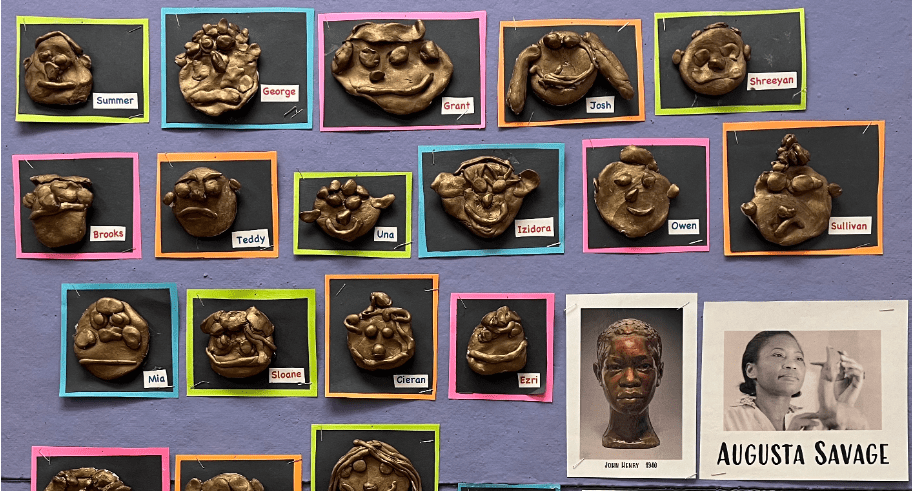
When fostering children’s expression and appreciation, our educators use the full range of teaching strategies I’ve been emphasizing this year. Sometimes, we explain and demonstrate a particular technique, such as using different types of paint tools to generate textured effects. Other times, we briefly introduce children to a new medium, such as clay, and let them explore with their hands to see what ideas they have about what to do with it and how. Mostly, we use a combination of these approaches so that the teachers can support the children’s explorations with “just in time” instruction, meaning provision of tools and tips right when they are needed for children to act on the ideas they share.

When viewing art created by others, we ask the children what they notice about the piece, what they wonder about, and may then provide some specific information about the artist’s interests, technique, etc. As with any explorations, we balance opportunities to explore deeply within one context with experiences that reveal diverse possibilities. For example, when the Preschool 3’s studied Art & Artists this month, they experimented with paper collage techniques after learning about Henri Matisse, created clay face sculptures like Augusta Savage, and used recycled electronics from their take-apart week in the Make Shop to make ‘robot works’ in the style of Nam June Paik.
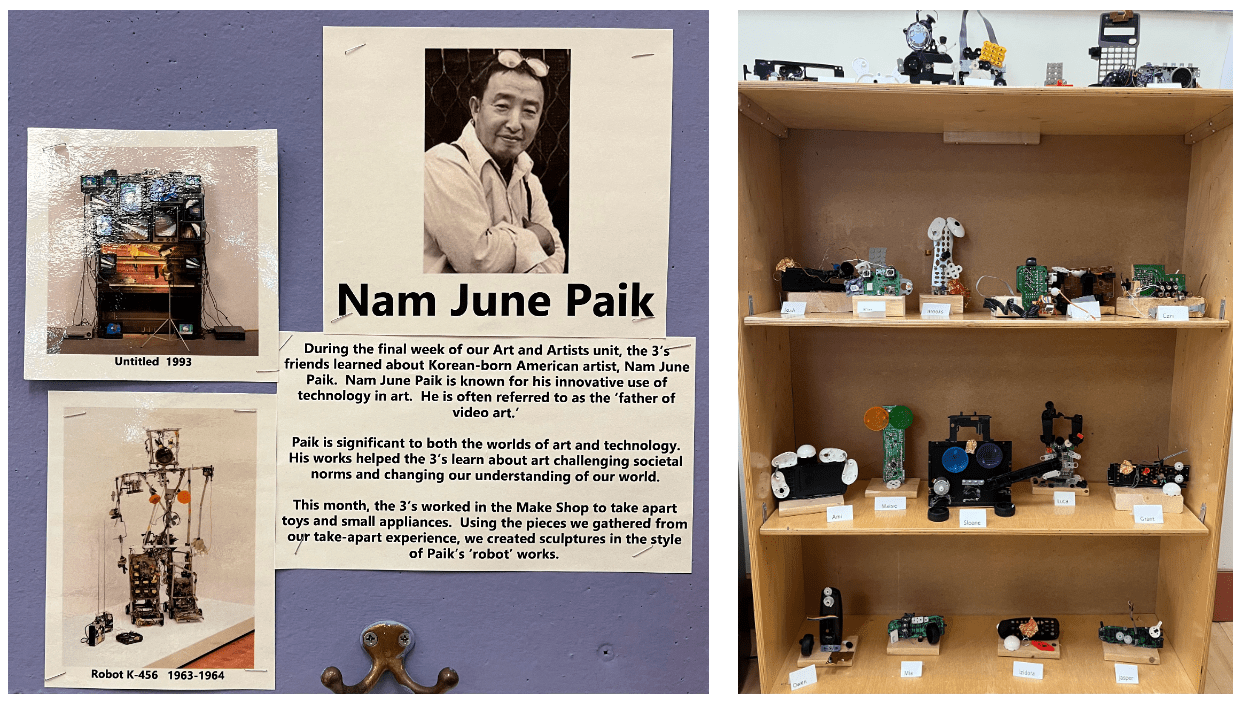
Skills from other domains of our developmental objectives are also strengthened when children explore the visual arts. Regarding Discovery & Exploration, open-ended visual art experiences strengthen children’s senses and build skills of observation, particularly with respect to features of line, shape, color, and texture. These features can then be used for comparing and contrasting, sorting, and counting. Children can experiment with art media and techniques in both 2- and 3- dimensions, as well as generate hypotheses about artists’ intent and methods. Art typically strengthens fine motor, eye-hand coordination, and tool use skills, but gross motor skills can also be developed as children work while standing and moving or on large projects, particularly those our educators arrange in outdoor spaces.

With respect to Communication, oral expression is central to discussions about art, but the key is to connect the visual representations with their meaning. Skills for using illustrations to help with story understanding and analysis can aid comprehension, and then those skills can transfer to choices children make when illustrating their own writing. Skills related to emotion and empathy are crucial in the arts, as well as skills for confidently describing your own perspectives and identifying with those of family and community (Self-Esteem & Independence). Using art materials appropriately requires following rules and directions, sharing and taking turns, persisting with the task, and then cleaning up, all of which are key skills for Interaction & Cooperation. Similarly, appreciating others’ work requires a respect for differences, the ability to take other perspectives, and the disposition to work together in a productive manner.
Throughout the year, I encourage you to engage with your children in both noticing the artistic beauty around you and in expressing your own creative ideas through the visual arts. Our Preschool 3’s families have been creating with recycled CD’s this month. What can you create?
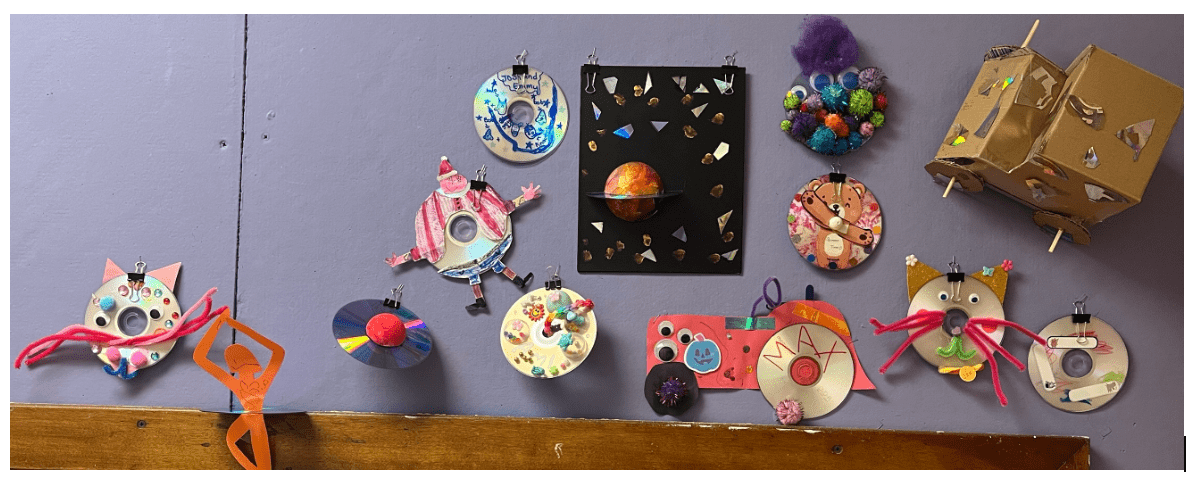
January 2025: Exploring Stories
Why should we encourage children to explore stories? People learn, grow, and build relationships by telling and listening to stories. We typically begin with books because inquiry with books helps children notice the key features of stories that matter to those who love them, as well as to begin linking cause and effect within the social contexts represented in both fiction and non-fiction narratives. With young children, the primary goal is NOT to teach reading directly, but rather to foster a love of stories that motivates a lifetime of engagement with text. Most children who have many opportunities to explore books with capable readers who encourage their inquiries and applaud their efforts will naturally develop strong reading skills.
One of my favorite times with my daughter decades ago and now with my granddaughters is reading aloud and discussing stories. We started with small “board books” or books made of cloth, both of which encourage very young children to independently manipulate the texts so that they can explore them with their hands and mouth while learning to physically orient the book correctly and manage the page turning. Toddlers already delight in choosing a book themselves and then initiating an interaction with interested readers by handing one of them a book and raising their arms to be drawn into a comfortable reading position. Of course, early reading is teaching many new words, but the cooperative exchanges related to the story and illustrations promote many aspects of communication. The book topics help teach children of all ages about science, math, social studies, etc., and reading sessions involve exploration of varying voices to represent different characters and emotions, as well as to distinguish narratives that are serious vs. silly. Reading stories again and again helps children identify the texts’ rhythms and patterns, as well as experience a variety of ways to creatively tell the same story, particularly when we are exploring the same topics in the real world, such as reading about daily life indoors and outdoors.
As with all explorations, Children’s School educators extend what families have begun by utilizing varied strategies on the teaching continuum to engage preschoolers and kindergartners with stories in ever deepening ways. While reading books related to our themes, we explicitly teach the meaning of author, illustrator, fiction, non-fiction, etc., and we engage children in discussions of each story’s characters, setting, and plot (starting with simple statements of the beginning, middle, and end). Families can often see how we model story reading because the children typically imitate it when they “play school” at home. All of our classrooms have “library corners” where children can independently choose books to “read” by themselves and where adults will read books that the children choose from our rotating options. Our 6,000+ book collection at the Children’s School has a wide range of titles available so that the children can explore books related to their unique interests and so that teachers can select ones that will help the group consider issues that are arising in the classroom or in their lives.

During February, we will be extending our explorations through our Whole School “Stories and Storytelling” Unit. We will have opportunities to experiment with different types of stories, such as anecdotes, legends, fairy tales, fables, etc. We will also experiment with stories in a variety of forms, beginning with books but progressing to songs, puppet plays, dramatic retellings, etc. Along the way, children will be encouraged to create their own versions of stories, such as our Preschool 4’s recently did with the “Five Little Monkeys” song/story. Dictating stories, such as “boo-boo stories”, and writing collaborative stories are fun ways for young children to explore their role as authors and then illustrators of their own original books.
Families can begin these explorations by sharing favorites and visiting the public library to discover new stories that might become favorites. Winter is a wonderful opportunity for everyone to enjoy cozy reading together, to explore different authors’ and illustrators’ versions of stories, and to discuss the meaning of stories in our lives. We look forward to the children sharing their learning with us so that we might explore all kinds of stories together.
December 2024: Exploring Games
Family time during holiday visits and winter vacations is a fantastic time to engage children in game play, so this month’s article focuses on the benefits of exploring games. Card games and Yahtzee were my childhood family favorites, and I’ve explored many more with my daughter and granddaughters.
Game play invites children to master skills in all domains, which enhances both self-esteem and independence. Game playing fosters interaction and cooperation because many games involve direction following and turn taking. Team games involve cooperation and peer support, as well as a chance to learn sportsmanship. The more children play together, the better they understand other children’s points of view, demonstrate empathy and caring, and develop conflict resolution skills. As children interact during games, they learn communication skills to describe their play, negotiate rules, plan strategies, etc. Their vocabulary increases as they learn words for new objects and actions in a variety of games. Children’s game play provides many opportunities for strengthening cognitive skills that support discovery and exploration. Attention, observation, memory, and problem solving are enhanced as children develop and test game playing strategies. During game play, children’s physical capabilities are often challenged, which builds both small and large motor skills naturally. Increasing physical prowess builds self-esteem and enables greater independence in play, which also gives children opportunities to learn how to control themselves and their bodies so that everyone can play safely. There are even games that support the growth of artistic expression & appreciation because they involve acting, drawing, etc.
Educators and parents can support game play using the full range of teaching strategies. Of course, direct instruction is necessary for learning the basic terms and rules of play, but more of a coaching approach is useful for discussing strategy options and helping children to consider which to use when. Exploring game variations and creating novel games invites children to negotiate standards of play and perhaps adapt the rules to specific contexts or players. Even open-ended discovery has a role in strengthening children’s game play, particularly when trying strategies for pulling blocks safely out of a Jenga tower or trying different levels of force when throwing a ball. By providing children with space, opportunities, materials, and appropriate scaffolding for their game explorations, we can encourage children to experiment to find what works best and then practice to master the skills and strategies for effective game play as individuals and while working as part of a team.
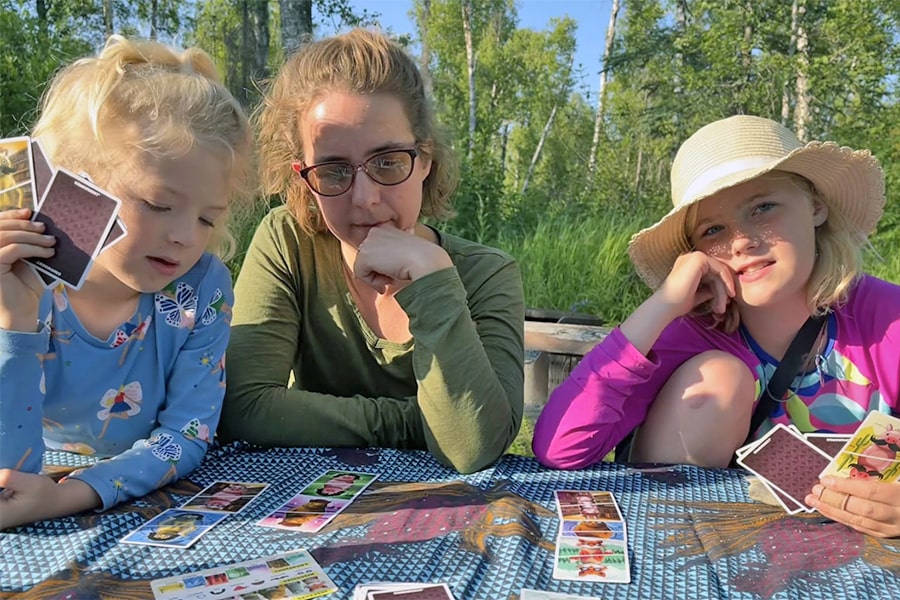
During the winter months, consider the games you have available and ways you could invite children to both participate in more traditional game play and invent their own games. Matching and memory games are very easy to make from everyday materials. Marbles, dominoes, and cards can all be used in diverse ways by players of all ages, so start by teaching some of the simple, common games so that children are comfortable with the basic possibilities. Then suggest that they make their own versions of the games to play with their peers or families. If you have a safe indoor space to play with soft, small balls, such as ping pong balls or Nerf balls, children can have lots of fun exploring ways to toss them though hoops or into containers, while inventing different point systems for distance or accuracy. Through it all, emphasize playing a “good game” by trying your best, playing fair, and playing safe. That way, everyone wins!
November 2024: Exploring Nature
Our theme for this year’s Director’s Corner articles is Why Explore?
Open-ended exploration of materials in diverse spaces promotes inquiry that starts with noticing interesting features, wondering about cause / effect relationships, thinking of possible explanations and testing them, and then learning from the outcomes. Nature provides engaging opportunities for children’s self-initiated discovery that blossoms into interests that children are motivated to pursue, both on their own and with the guidance of educators who are prepared to involve them in more systematic inquiry and deeper learning from books, experts, and other sources. We scaffold with the prompts, “I notice ___, I wonder ___, I think ___, and I learned ___” to support children’s use of the inquiry process and then introduce the formal scientific vocabulary.
Richard Louv’s 2005 book, “Last Child in the Woods: Saving Our Children from Nature Deficit Disorder” aims to encourage discussion of “the increasing divide between the young and the natural world, and the environmental, social, psychological, and spiritual implications of that change” (p. 2). Since our educators read that book fifteen years ago, we have worked purposefully to include nature in the classroom, focus more on “nearby nature”, make our school more “green”, and improve our “outdoor classroom”. For example, our classrooms now include more plants and a few pets, we take more walks on campus and in Schenley Park, we have broadened our recycling and composting programs, and we have added more natural elements and gardens in our outdoor space. Both CMU and the city of Pittsburgh have supplemented our efforts with their own steps toward “green urbanism”. One result of these efforts is that this fall our children and educators have had opportunities to observe diverse songbirds, squirrels, chipmunks, rabbits, and even a deer on or near our playground. Nature at its best!
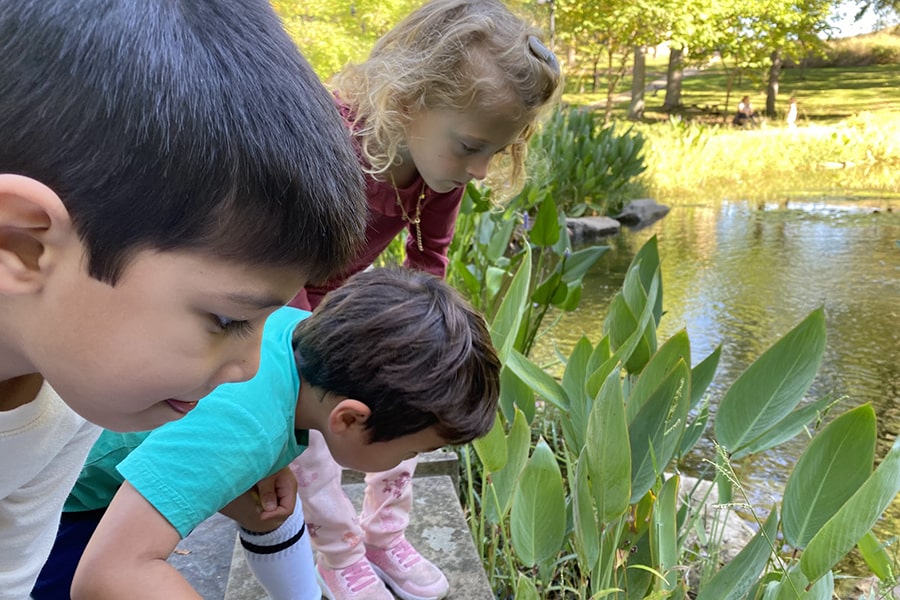
With nature explorations, our educators utilize the full continuum of teaching strategies, from encouraging open-ended discovery, to modeling and coaching inquiry, to direct instruction. For example, our “mud kitchen” on the playground invites free exploration for all ages, Preschool 4’s class participates in caring for our “worm farm”, and the PreK/Kindergarten class used the pumpkins provided to each child by the Facilities Management team for a “pumpkin palooza” of math and science inquiry. The teachers respond to children’s questions and supplement the group experiences by sharing non-fiction nature books, showing time lapse video sequences or web cams of natural habitats, inviting experts to talk with the children, etc.
Why do these efforts matter? During nature investigations, children have opportunities to progress in all developmental domains. For example, nature explorations help children gain confidence in their skills and foster initiative (Self-esteem & Independence), encourage peers to support each other’s ideas and negotiate plans (Interaction & Cooperation), provide rich topics of conversation and contexts for recording observations (Communication), provoke inquiry with diverse opportunities to compare, sort, and quantify (Discovery & Exploration), build skills for controlled movement and use of tools while managing risks (Physical Capabilities / Health & Safety), and inspire children to both perceive and create beauty (Artistic Expression & Appreciation).
Remember, exploration is more about noticing, wondering, and predicting than about knowing all the answers. So, relax and venture outdoors with your family. You’ll be amazed at what you can discover together!
October 2024: Why Explore?
Early childhood educators utilize a broad continuum of teaching strategies to facilitate children’s learning. For example, at the beginning of the school year, we directly teach one hand-washing strategy with an accompanying song so that all the children learn the “best-practice” procedure, but we invite more open-ended discussion to negotiate the classroom meaning of “be a kind friend”. Also, we provide multiple opportunities in the context of dramatic play, block building, sand table exploration, playdough creation, etc., for children to discover ways to interact effectively with their peers, all with the support of adults who model appropriate behaviors.
The same continuum of strategies applies to our support for learning in all developmental domains, including self-esteem & independence, interaction & cooperation, communication, discovery & exploration, physical capabilities / health & safety, and artistic expression & appreciation. We use the more “teacher-directed” strategies when they are efficient and effective for learning facts, rules, techniques, and other procedures. Discovery approaches via play and other open explorations are very useful for helping children notice interesting features of the world, themselves, and others, observe cause and effect relationships in the physical and social spheres, and begin to ask questions about how things work. Such discoveries serve as “preparation for future learning” in that they spark interest and build experience that serves as a foundation for inquiry activities that are structured and guided by the teachers to help children build key concepts in all of the topic areas within science, math, social studies, literature, the arts, technology, etc.
Since young children are essentially universal novices, they benefit from having a range of opportunities to safely explore interesting spaces and materials both indoors and outdoors. These explorations promote interest, engagement, and creativity – essentially a positive and proactive approach to learning. Exploring also strengthens skills in all developmental domains.
- Self-Esteem & Independence – pride in achievements & motivation to independently explore
- Interaction & Cooperation – inclination to work and learn collaboratively
- Communication – emphasis on descriptive language to share discoveries
- Discovery & Exploration – disposition to experiment and extend learning via the inquiry cycle
- Physical Capabilities, Health & Safety – skilled and safe use of bodies with purpose and control
- Artistic Expression & Appreciation – investment in creative outlets, both your own and others’
To give a concrete example, exploring playdough enables children to independently pursue their own ideas and projects, as well as to experiment with different tools and materials that we provide with the playdough. Working with playdough strengthens children’s hand muscles, encourages eye-hand coordination, and builds tool use skills – all in ways that are within their developmental reach. When peers are involved, the playdough work affords children the opportunity to learn social interaction skills for sharing and conversation skills for communicating their ideas and making their requests known. Either individually or with peers, children can build artistic expression skills for both visual arts and pretend play. In my Director’s Corner articles this year, I plan to share the benefits of children learning through explorations of nature, construction, literature, cooking, etc. We hope you will explore with us!
Children’s School - Famous Playdough Recipe
1 cup White Flour
½ cup Salt
2 teaspoons Cream of Tartar
1 cup Water
1 tablespoon Oil
1 teaspoon Food Coloring
NOTE: We usually double the recipe. Giant Eagle sells LARGE containers of Cream of Tartar.
- Combine flour, salt, and cream of tartar in a saucepan. Mix water, oil, and food coloring in a separate bowl and stir them gradually into dry ingredients until the mixture is smooth.
- Cook over medium heat, stirring constantly until a ball forms.
- Remove from heat and when the mixture is just cool enough to handle, knead until smooth.
- Also, you can add vanilla, instant coffee, etc. to add aroma, or add glitter to enhance the visual sensation. Be creative! The playdough stores best in a ziplock bag in the refrigerator.
